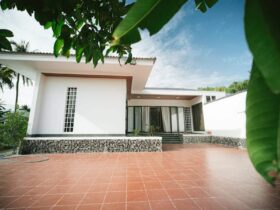When choosing between slate and composite roofing, consider factors such as durability, maintenance, and cost. Both slate and composite roofs have their advantages and disadvantages, so it’s essential to weigh these aspects carefully before making a decision.
Slate roofs are renowned for their longevity and classic aesthetic appeal, but they can be heavy and may require special care during installation and maintenance. On the other hand, composite roofs offer durability and a more affordable price point, but they may not have the same natural look as traditional slate.
Understanding the differences between these options can help homeowners make an informed choice when it comes to selecting the best roofing material for their needs.
Introduction To Slate And Composite Roofing
Comparing slate and composite roofing reveals that while slate offers natural beauty and longevity, it is heavy and can be prone to damage. On the other hand, composite roofing provides durability and cost-effectiveness, but may not offer the same aesthetic appeal as slate. Homeowners should consider the pros and cons of each before making a decision.
The Rise Of Composite Materials
Composite roofing materials have gained popularity in recent years due to their versatility, durability, and cost-effectiveness. Unlike traditional materials like slate, composite roofs are made from a combination of synthetic materials such as plastic, rubber, and recycled materials. These materials are engineered to mimic the look and feel of natural materials, while offering improved performance and a longer lifespan.
Historical Use Of Slate In Roofing
Slate has been used as a roofing material for centuries, known for its natural beauty and exceptional durability. It has been a popular choice for historic buildings, castles, and churches due to its ability to withstand the test of time. Slate roofs are known to last for over a hundred years if properly installed and maintained.
However, one drawback of slate is its brittleness. Direct impact damage can cause cracked or broken tiles, requiring professional repair or replacement. Nevertheless, slate roofs are still a preferred choice for those seeking a timeless and elegant look for their homes.
In contrast, composite roofs offer numerous advantages over traditional slate roofs. They are lightweight, making installation easier and reducing the stress on the structure of the building. Composite materials are also more resistant to impact damage, making them a suitable option for areas prone to severe weather conditions.
Composite roofs are also more cost-effective compared to slate roofs. The materials used in composite roofing are more readily available and less expensive, making them a more affordable option for homeowners. Additionally, composite roofs can be designed to mimic the appearance of slate, providing a similar aesthetic without the high cost.
Furthermore, composite roofs are eco-friendly as they often incorporate recycled materials. They are also energy-efficient, offering improved insulation and reducing heating and cooling costs.
In conclusion, while slate roofs have a long-standing history and offer a classic aesthetic, composite roofs have emerged as a practical and cost-effective alternative. With their durability, versatility, and eco-friendly features, composite roofs have gained popularity in the roofing industry. Whether you choose the timeless elegance of slate or the modern advantages of composite, both options have their own unique benefits to offer.

Credit: www.billraganroofing.com
Physical Properties And Aesthetics
When it comes to choosing a roofing material for your home, it’s important to consider both the physical properties and aesthetics of slate and composite roofs. Let’s delve into the key differences and advantages of each option.
Slate’s Natural Charm
Slate roofing offers a timeless and natural charm that is hard to replicate. Its unique, earthy tones and textures add a touch of elegance to any home. The natural variation in color and pattern of slate tiles creates a visually appealing and distinctive roof surface that stands out in the neighborhood.
Composite’s Versatility In Design
Composite roofing, on the other hand, provides unparalleled versatility in design. It can mimic the look of various roofing materials, including slate, wood, and even metal. This allows homeowners to achieve their desired aesthetic without compromising on performance. Additionally, composite roofing comes in a wide range of colors and styles, offering endless design possibilities.
Evaluating Durability And Longevity
When comparing the durability and longevity of slate roof versus composite, it’s important to note that slate roofs offer impressive resistance to weather, pests, and fire, but can be prone to cracking from direct impact. On the other hand, composite roofs, while durable, may not last as long as premium materials and can be vulnerable to color fading over time.
The Resilience Of Slate
Slate roofing is known for its durability, longevity, and resistance to harsh weather conditions. It can withstand heavy rains, hail, and strong winds. Slate roofs can last for more than a century, making them a popular choice for historical buildings and homes. Additionally, slate roofs are fire-resistant and insect-proof. However, one of the drawbacks of slate roofs is their weight. They are much heavier than composite roofs, which can make installation more challenging and expensive.
Composite’s Lifespan Considerations
Composite roofing, on the other hand, is made from a mixture of materials such as plastic, rubber, and recycled materials. Composite roofs are lightweight and easy to install, making them a cost-effective alternative to slate roofs. They are also available in various colors and styles, making them an attractive option for modern homes. However, composite roofs have a shorter lifespan than slate roofs, typically lasting between 20 to 50 years. They are also susceptible to fading and may not be as fire-resistant as slate roofs.
Comparing Durability And Longevity
When it comes to durability and longevity, slate roofs outshine composite roofs. Slate roofs can last for more than a century, while composite roofs have a lifespan of up to 50 years. Additionally, slate roofs are more resistant to harsh weather conditions, fire, and pests than composite roofs. However, composite roofs are more cost-effective and easier to install than slate roofs.
In conclusion, whether you choose a slate or composite roof depends on your budget, style preference, and the climate of your area. Both types of roofs have their advantages and disadvantages, and it is essential to evaluate them carefully before making a decision.
Cost Considerations For Homeowners
When considering cost, homeowners should weigh the pros and cons of slate roofs versus composite options. While slate offers high curb appeal and a long lifespan, it is heavy and expensive. Composite shingles offer a more affordable alternative that is eco-friendly and durable, but may not last as long as premium roofing materials and can be vulnerable to color fading.
Initial Investment For Slate Vs. Composite
When considering a roofing material for your home, one of the first factors to consider is the initial investment. Slate roofs are known for their elegance and durability, but they come with a higher price tag compared to composite roofs.
Slate roofs, made from natural stone, require skilled craftsmanship for installation, which contributes to their higher cost. On the other hand, composite roofs, made from synthetic materials like rubber or plastic, are more affordable.
It’s important to note that these figures are approximate and may vary depending on factors such as the size of your roof and the region you are located in. However, it’s clear that slate roofs require a larger upfront investment compared to composite roofs.
Long-term Financial Implications
While the initial investment is an important consideration, homeowners also need to evaluate the long-term financial implications of their roofing choice.
When it comes to slate roofs, their longevity is a major advantage. Slate roofs can last for over a century when properly maintained, meaning homeowners may not have to worry about replacing their roof for a lifetime. This long lifespan can save homeowners money in the long run, as they won’t have to incur the cost of frequent roof replacements.
On the other hand, composite roofs have a shorter lifespan compared to slate. While they are still durable and can last several decades, they may require replacement sooner than slate roofs. This means homeowners may need to budget for roof replacements in the future.
Additionally, it’s important to consider the maintenance and repair costs associated with each roofing material. Slate roofs generally require minimal maintenance, while composite roofs may need occasional repairs and replacement of damaged shingles.
In conclusion, while slate roofs have a higher initial investment, their long lifespan can provide long-term financial benefits. On the other hand, composite roofs offer a more affordable upfront cost, but homeowners may need to budget for future replacements.
Installation And Maintenance Factors
When considering Installation and Maintenance Factors of slate roof vs composite, it’s essential to delve into the specifics of each roofing material.
Complexities Of Installing Slate
- Requires skilled professionals
- Heavy and labor-intensive process
- Precision in cutting and placing
Ease Of Composite Roof Maintenance
- Simple cleaning with water
- Resistant to mold and mildew
- Regular inspections for longevity
Environmental Impact And Sustainability
In the debate between slate roof and composite, environmental impact and sustainability are key factors. While slate offers durability and natural beauty, composite provides a more eco-friendly and cost-effective option with higher durability levels. Both choices have pros and cons in terms of longevity and impact on the environment.
Eco-friendliness Of Roofing Materials
Choosing a roofing material that has minimal environmental impact is becoming increasingly important for homeowners. When it comes to comparing slate and composite roofing, it’s important to consider the eco-friendliness of each material.
Natural slate is a mined material that is formed over thousands of years. Slate is a natural resource that is harvested and transported to manufacturers for processing. On the other hand, composite roofing materials are made from a combination of recycled plastics and rubber materials. While composite roofing materials are made from recycled materials, they still require energy to manufacture and transport.
Recyclability And Energy Efficiency
Another important factor to consider when it comes to the environmental impact of roofing materials is recyclability and energy efficiency. Slate roofing is a highly durable material that can last for over 100 years. At the end of its lifespan, slate can be recycled and repurposed.
Composite roofing materials, on the other hand, are not currently recyclable. While composite roofing materials are long-lasting, they will eventually end up in landfills at the end of their lifespan. Additionally, the manufacturing process for composite roofing materials requires a significant amount of energy.
In terms of energy efficiency, slate roofing has a high thermal mass, which means it can absorb and retain heat. This can help to reduce energy costs by keeping the home cooler in the summer and warmer in the winter. Composite roofing materials, on the other hand, have a lower thermal mass and may not provide the same energy efficiency benefits.
When it comes to comparing the environmental impact and sustainability of slate roofing vs composite roofing, both materials have their pros and cons. While natural slate is a mined resource, it is highly durable and can be recycled at the end of its lifespan. Composite roofing materials are made from recycled materials but are not currently recyclable and require energy to manufacture. Ultimately, the decision between slate and composite roofing will depend on a variety of factors, including cost, durability, and environmental impact.
Frequently Asked Questions
What Is A Drawback Of A Slate Roof?
A drawback of a slate roof is that it is brittle and can crack or break if it experiences a direct impact. However, replacing individual slate tiles is not difficult for a professional roofing company.
What Are The Disadvantages Of Composite Roofs?
Composite roofs have some disadvantages to consider. While they are durable, they may not last as long as premium roofing materials. They can also be vulnerable to color fading due to UV exposure. Additionally, composite roofs can be heavy and may require modifications to sustain their weight.
Why Is Slate Not Used For Roofing?
Slate is not commonly used for roofing because it is brittle and can crack from impact. Walking or placing heavy equipment on slate tiles can cause damage, requiring special care during installation and maintenance. This is why slate roofs are not suitable for installing solar panels or other heavy equipment.
What Is Better Roof Tile Or Composite?
Composite roof tiles are a better option compared to traditional roof tiles. They are eco-friendly, durable, and cost-effective. Concrete and clay tiles can be heavy and expensive, while shingle roofs have a shorter lifespan. Composite tiles offer the aesthetic appeal of traditional slate at a fraction of the cost and with higher durability.
Can Composite Roofs Fade Over Time?
Composite roofs may experience color fading due to UV exposure, affecting their appearance.
Conclusion
Both slate and composite roofs have their unique advantages and drawbacks. Slate offers exceptional durability but is prone to impact damage. On the other hand, composite roofs are cost-effective and eco-friendly, but may not have the same longevity. Ultimately, the choice depends on individual preferences and budget constraints.










Leave a Reply